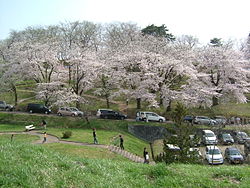Akayu, Nanyo
|
Akayu 赤湯町 |
|
|---|---|
| Former municipality | |

Cherry blossoms in Eboshiyama Park, Akayu
|
|
| Location in Japan | |
| Coordinates: 38°03′N 140°11′E / 38.050°N 140.183°ECoordinates: 38°03′N 140°11′E / 38.050°N 140.183°E | |
| Country | Japan |
| Region | (Tōhoku) |
| Prefecture | Yamagata Prefecture |
| District | Higashiokitama District |
| Merged | April 1, 1967 (now part of Nan'yō) |
| Area | |
| • Total | 41.10 km2 (15.87 sq mi) |
| Population (1965) | |
| • Total | 12,860 |
| • Density | 313/km2 (810/sq mi) |
| Time zone | Japan Standard Time (UTC+9) |
Akayu (赤湯町 Akayu-chō) was a town located in Higashiokitama District, Yamagata Prefecture, Japan.
As of 1967, the town had an estimated population of 12,860 and a population density of 313 persons per km². The total area was 41.10 km².
On April 1, 1967, Akayu was merged into the expanded city of Nan'yō and thus no longer exists as an independent municipality.
The village of Akayu was established on April 1, 1889 with the establishment of the municipalities system. It was raised to town status on December 12, 1895. On June 10, 1955 the village of Nakagawa was annexed by Akayu. On March 21, 1957, the Nakayama neighborhood of Akayu was annexed by the neighboring city of Kaminoyama. On April 1, 1967 the town of Akayu merged with the town of Miyauchi and the village of Wagō to form the city of Nan'yō
English travel writer Isabella Bird visited Akayu on her travels in Japan in 1878. In Unbeaten Tracks in Japan she wrote of Akayu:
the frequented watering-place of Akayu in the north, is a perfect garden of Eden, 'tilled with a pencil instead of a
plough,' growing in rich profusion rice, cotton, maize, tobacco, hemp, indigo, beans, egg-plants, walnuts, melons, cucumbers, persimmons, apricots, pomegranates; a smiling and plenteous land, an Asiatic Arcadia, prosperous and independent, all its bounteous acres belonging to those who cultivate them, who live under their vines, figs, and pomegranates, free from oppression--a remarkable
Akayu is most famous for Akayu Onsen (赤湯温泉), a series of ryokan famed for their natural hot-springs which are believed to have medicinal properties.The town's name, which is literally translated as "red hot water", derives from a story in 1093. It is said that the feudal chief of Mutsu Province, Minamoto no Yoshitsuna took a wounded soldier to a hot spring bath. His blood immediately turned the water red and the wound closed.
...
Wikipedia

